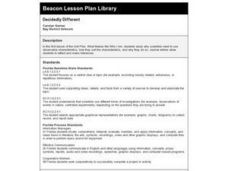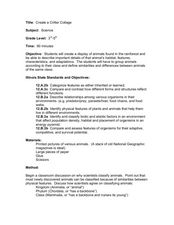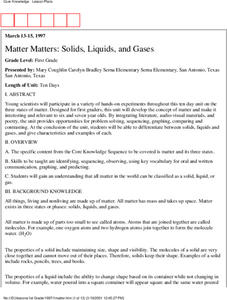Curated OER
Fish Count
In this science worksheet, students read about how scientists determine the total number of fish in a population. Students also participate in a related math activity.
Curated OER
Analyzing Intertidal and Deep Sea Vent Communities
Students study how scientists measure diversity. For this diversity lesson students look at marine communities and look at data to calculate diversity in 3 different ways.
Curated OER
Stonehenge: Solving Ancient Mysteries
Students explore archeologists and anthropologists and the tools and methods they use to gather and interpret scientific evidence. They research current archaeological excavations and contact the scientists working at these digs.
Curated OER
Cancer Causes
Students explore why people get cancer. They explore human cells by taking a close examine their own. take a small sample of the epithelial cells that line the inside of their mouth. They glimpse how scientists investigate inside cells.
Curated OER
Decidedly Different
Fifth graders inquire as to why scientists use observable characteristics, how they sort the characteristics, and why they do so. They write journal entries to be used throughout this unit.
Curated OER
Spotlight On Stem Cells
Learners discover the differences in how stem cells develop and function depending on their source. They see how scientists are using stem cells - from a variety of sources - to study how they can be used to cure certain illnesses and...
Curated OER
Erosion Lab
Eighth graders explore variables that influence the rate of erosion due to the 4 major agents. They work as a group and practice conducting experiments according to the scientific method. Students comprehend that communicating ideas...
Curated OER
Exploring the Planets
Students study robotic spacecrafts that have provided detailed information about the inner and outer planets. In this exploring the planets lesson plan, students use posters and diagrams to study the various robotic spacecraft sent to...
Curated OER
Reflections on Earth: Exploring Planet Earth from Space
Students examine satellite images of Earth and contrast images at different scales. In this exploring Earth from space lesson plan, students use satellite images to contrast images at different scales, calculate distances from the scale...
Curated OER
Designing an Underwater Habitat for Humans
Students consider the limitations of deep water oceanography and design an underwater habitat to support scientists while they complete long term studies under the ocean. In this engineering lesson plan, students are introduced to the...
Curated OER
History of Saturn Discoveries
Students interpret how scientists have explored Saturn. In this NASA based astronomy lesson, students create a timeline depicting the study of Saturn from 1610 until 2010. Each student will write a letter to Galileo discussing how the...
Curated OER
Deep Jungle: New Frontiers
Students watch a series of videos and observe the different plants and animals found in the rainforests. In this ecology lesson, students discuss how technology helped scientists study the jungle. They create 3D maps of Borneo rainforests.
Curated OER
Flightless Birds and Scientific Research
Students study the work done by various scientists on Antarctica. In this biology lesson plan, students play the role of researchers who must justify the importance of their study. They create a multimedia presentation about a specific...
Curated OER
The Discovery of Photosynthesis
Students explore how scientists discover photosynthesis. In this biology lesson, students identify the basic requirements for photosynthesis to happen. They recreate past scientists' experiments and record their observations.
Curated OER
2005 Submarine Ring of Fire Expedition: Unexplored
Students compare and contrast submarine volcanoes at convergent and divergent plate boundaries, infer kinds of living organisms that may be found around hydrothermal vents, and describe ways in which scientists may prepare to explore...
Curated OER
Create a Critter Collage
Young scholars create a collage. In this animal classification lesson plan, students discuss why and how scientists classify animals. Young scholars view pictures of different animals and decide which class each animal belongs to....
Curated OER
Call to Arms
Students explore how scientists build robotic arms that move similar to humans. In this robot lesson, students examine how scientists make robots. Students design and construct a mechanical arm that moves like a human arm. Students...
Curated OER
Matter Matters: Solids, Liquids and Gases
Scientists participate in a variety of hands-on experiments in this ten-day unit on the three states of matter. Lessons incorporate literature, a-v materials, and poetry to help students differentiate between solids, liquids and gases.
Curated OER
Making the Invisible Visible
Students evaluate the various ways in which cyberspace is beginning to be mapped by geographers, cartographers, artists, and scientists and use their understanding of the information these new maps can convey to create their own maps of...
Curated OER
Sequencing Time
Learners place events in sequence and assign relative times to each event. They gain an understanding of relative and numerical time and become familiar with the methods used by scientists to develop the Geologic Time Scale.
Curated OER
Digging Into the Past
Students participate in an excavation simulation, and explore the ruins of Sardis. They ponder which clues scientists use to determine if artifacts found in the excavation are of Persian, Greek, Roman, Byzantine, or Lydian origin.
Curated OER
Mind Over Matter: How Does the Brain Work
Students research previous attempts by scientists to discover the ways in which the brain works, design and conduct an experiment to illustrate current research and present their findings to the class.
Curated OER
Draw T. rex
Students explore how scientists determine what prehistoric animals looked like based on their bones. They draw a picture of the skull of a Tyrannosaurus Rex by copying an image from an overhead or book.
Curated OER
Chicago: The City in Art, 1995-2000
Learners examine a mural of animals and talk about animal classification. They act as scientists and keep a record, called a Jungle Journal, of plants and animals they observe while studying the rainforest.
Other popular searches
- Famous Scientists
- Famous Scientists Alive
- 10 Famous Scientists
- Cell Theory Scientists
- Famous Scientists Botany
- Social Scientists
- Famous Scientists From Italy
- 5 Famous Scientists
- Famous Scientists Reports
- Famous Scientists Project
- 40 Famous Scientists
- Famous Scientists in Florida























